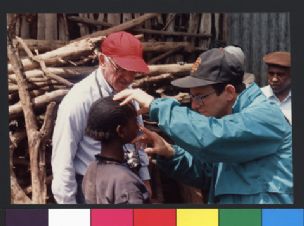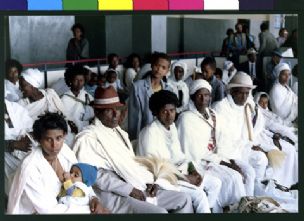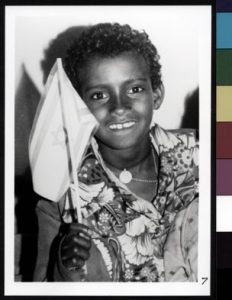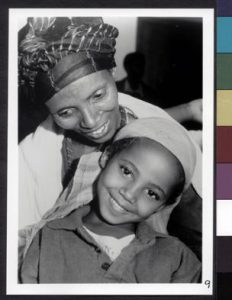- Pulished by
-
AD Media at
-
May 30, 2023
A Historic Airlift Rescuing 14,000+ Ethiopian Jews in 36 Hours

May marks the 32nd anniversary of Operation Solomon, the covert operation to airlift over 14,000 Ethiopian Jews to Israel in 36 hours. In the spring of 1991, Ethiopia had been in a decades-long civil war and rebel forces were threatening to close in on Addis Ababa, the nation’s capital. There was fear that the unrest could create a dangerous situation, with Ethiopian Jews being caught in the crossfire. The Israeli government together with the Jewish agency JDC intervened and the rescue operation named “Operation Solomon,” was devised. There was a small window of opportunity for Jewish Ethiopians to be airlifted by plane from Ethopia to Israel.The mission to bring Ethiopian Jews to Israel was entrusted to the JDC, who partnered with the Israel Defense Forces, the American Association for Ethiopian Jews, and the Jewish Agency. Non-stop flights continued for 36 hours to bring more than 14,000 Ethiopian Jews to Israel over a single weekend, a world record.
The JDC (Joint Distribution Committee) Leaves No One Behind.

The JDC, or the Joint Distribution Committee is the worlds largest Jewish humanitarian Jewish Agency providing aid and support to communities in over seventy countries around the globe. The JDC has a 150 year history of providing humanitarian aid and support. The Ministry of Health, Ethiopia, in partnership with JDC announced last in 2022 the launch of a new project titled “Health System Strengthening: Support for Conflict-Affected Hospital Restoration and Capacity Support to Ethiopian Prosthetic and Orthotic Services (EPOS)”. The project made a positive impact on the community and provided valuable resources to restore basic health services in conflict-affected areas.It supported Ethiopian Prosthetic and Orthotic Services (EPOS) in enhancing emergency response capacity for people with disabilities due to conflict casualties and other factors.

Additionally, the project effectively identified and addressed system-related bottlenecks in nationally selected hospitals in Ethiopia, with a budget of 3.9 million USD.
Unwavering Compassion: Dr. Rick Hodes’ Remarkable Contribution to the Ethiopian Community
Another remarkable contribution to the Ethiopian community is made by Dr. Rick Hodes, an exceptional spine doctor and an exemplary humanitarian, serving as JDC’s medical director in Ethiopia. Since his arrival in Addis Ababa in 1985, his remarkable journey has been defined by transformative encounters and unwavering dedication. Dr. Hodes established a dedicated spine clinic in 2006 to cater to the most vulnerable individuals in the region. He tirelessly attends to patients five days a week, having transformed the lives of well over 1,000 individuals. “No one is turned away at our doorstep,” declares Dr. Hodes.”We ensure that each person who seeks our help is seen on the same day, irrespective of their circumstances. Whether it’s arranging bus fare for transportation or finding suitable shelter for those without a home, we go the extra mile.” Dr. Rick Hodes and his invaluable work, supported by JDC, have become synonymous with unwavering compassion.
Ethiopian Jews

Ethiopian Jews can trace their origins around 587BCE or shortly after the destruction of the First temple. “The origin of Ethiopian Jews is unclear though most believe that they are the descendants of King Solomon and Queen Sheba. There are many theories though, some believing they are the lost tribe of Dan, while others believe they are the descendants of Christians who converted to Judaism. Throughout its history, the community has been referred to by numerous names like ‘’Falasha’’ which means ‘’stranger’’ which shows how their Christian neighbours viewed them as strangers in their land and ‘’Beta Israel’’ which literally means ‘’house of Israel’’. This name shows the community’s own deep connection to the Torah and their faith.”The Beta Israel or House of Israel as Ethiopian Jews called themselves has existed for at least 15 centuries. They relied on oral traditions and nomadic lifestyles with little written tradition. Today, little is known about their history. It has been suggested the Jewish community of Ethiopia arrived in Ethopia as merchants or artisans from various countries in the region. As a community they lived an isolated exsiting and developed a unique set of religious practices. Each community appointed its own leaders and followed its own practices. The Ethiopian community treated the Jewish community differently depending on who was in power.In 1624 for example, the rulilng king’s army captured many Ethopian Jews forcing them to be be baptised and denied them the right to own land. It wasn’t until a French historian, Joseph Halevy, visited the area that a more accurate first hand account came to light.
Ethiopian Jewish History In the 1970’s

The Beta Israel exodus to Israel began in the early 1980s, after a coup in the Ethiopian government led to the death of 2500 Jews, directly followed by Ethiopia forbidding the practice of Judaism and the teaching of Hebrew. This was the start of various operations conducted by Israel to rescue the Beta Israel community. In 1984 and 1985, there was a massive airlift of Ethiopian Jews to the land of Israel. Over a period of a few months, approximately 8,500 were taken to Israel in Operation Moses. Since 1914, JDC has played a vital role in rescuing over 1 million Jews facing danger across various regions, including Ethiopia, Georgia, Ukraine, and Sarajevo.

JDC’s commitment extended beyond the 1991 airlift and rescue Ethiopia’s Jews in danger. The people who arrived during Operation Solomon fled their country with nothing but the clothes they were wearing. JDC launched ongoing support programs to assist Ethiopian-Israelis in their new lives. These efforts reflect JDC’s dedication to developing innovative and impactful solutions to address complex social challenges. Operation Solomon, the largest-ever individual Aliyah mission undertaken from any country in the world to date, serves as a crucial reminder for Israel and world Jewry that all of the Jewish people are responsible for one another.
Operation Solomon – a significant historical event for Ethiopian Jewry

Operation Solomon was a significant historical event as it rescued and airlifted almost twice as many Ethiopian Jews to Israel. Unlike Operation was a significant historical event for Ethiopian Jewry as it rescued and airlifted almost twice as many Ethiopian Jews to Israel. Unlike Operation Moses, Operation Solomon had the coorporaation of the Ethiopian government. The Ethiopian government gave permission for Ethiopian Jews to leave Ethiopia. The JDC ground plan for the Operation Solomon involved gathering everyone at the Israeli embassy and transporting them to the planes using specially designated buses. Each bus was to be escorted by an Israeli soldier, of Ethiopian origin.
In order to accommodate as many people as possible, airplanes were stripped of their seats, planners expected the planes would hold only 760 passengers, but the Ethiopians – many of whom were malnourished – were so light that many more could fit and due to this and minimal baggage of the refugees, up to 1,086 passengers were boarded on a single plane. The children stayed close to their mothers. One of the first planes holds the Guinness world record for the most passengers on an aircraft. All the seats had been removed, and at least 1,078 people were on board, including two babies born in-flight.
JDC staff monitored food and fuel supplies in the embassy compound, bus transportation to the waiting planes, access to computerised case files, and an outreach system to summon the population to the compound once Operation Solomon had begun. But the story doesn’t end there.
Immigration and life in Israel

Life in Israel for Ethiopian Jews was varied. They had to assimilate into Israeli life and like any new immigrant had to face many unique challenges. Today over 140,000 Ethiopian Jews live in Israel with approximately 6,000 Ethiopian Jews still living in Ethiopia. The Ethiopian Jewish community has been in Israel for more than three decades, but the majority still live in the social periphery and face numerous diffiulties. Despite JDC efforts, Ethiopian Israelis continue to experience socio-economic gaps compared to the general population. The majority of Ethiopian Israelis reside in the central and southern districts of Israel, with approximately 38% and 24% living in these areas, respectively. Netanya has the highest number of Ethiopian residents, while Qiryat Mal’akhi has the highest percentage of Ethiopian residents out of the total population.

The birth rate among Ethiopian women in Israel is relatively high, with an average of 2.89 children per woman in 2020. Ethiopian Israelis face various challenges in terms of welfare, income, and employment. About one-third of Ethiopian-born individuals were registered at the Ministry of Welfare and Social Affairs in 2020, and approximately 81% of them were defined as needing intervention. The most common reasons for needing help were dysfunctional family situations, poverty, and employment issues. In terms of income and employment, Ethiopian households had an average income 35% lower than the Israeli average in 2015. More than 35% of Ethiopian Israeli families live below the poverty line, compared to 18.6% of Israeli families in general.

However, there has been an increase in employment rates among Ethiopians, with the percentage of employed individuals rising from 50 to 72% between 2003 and 2015. The percentage of women in the workforce also grew significantly during this period. While the number of Ethiopians holding “quality” jobs is low at 5% , the situation is improving as more Ethiopian Israelis attain higher education. Approximately 55% of Ethiopian university graduates are employed in high-quality positions, similar to the general Jewish population. However, there are still challenges in terms of salary disparities, as some Ethiopian graduates accept lower-paying jobs in fields such as nursing and teaching.
There are also concerns that Ethiopian job seekers have to change their names to sound less Ethiopian in order to increase their chances of employment. The education sector highlights significant gaps between Ethiopian Israelis and the general population. Standardised test scores in Hebrew, English, and math show widening gaps as grade levels increase. Nevertheless, the percentage of Ethiopian Israeli students taking matriculation exams in 12th grade was relatively high at 92% in 2019/20. However, only 48% of Ethiopian Israeli students with a matriculation certificate met university entrance requirements, compared to 73.1% of the total Hebrew education sector.
The number of Ethiopian Israelis in higher education has been increasing in recent years, with efforts made to encourage academic excellence and leadership among Ethiopian-Israeli students. Discrimination remains a concern for Ethiopian Israelis. Housing discrimination, police brutality, and over-policing are among the challenges faced by the community. Efforts have been made to address these issues, including the formation of a commission to combat racism and improve police interactions. However, the percentage of Ethiopians involved in criminal trials and the overrepresentation of Ethiopian-Israeli students in special education indicate ongoing challenges.
New immigrants from Ethiopia continue to arrive in Israel, with the government approving the entry of the “last group” of Ethiopian Jews in 2015. Efforts have been made to absorb Ethiopian Jews into Israeli society, and JDC is still at the forefront of settling them in.
Sources
BBC – Ethiopian Jews flown to Israel in latest operation
The New York Times – Israel’s Unfinished Exodus Story
Get updates from The Joint & JDC
It’s the easiest way to keep up to date with all our latest news, events and fundraising activities.
© 2024 The Joint Australia | Partner of American Jewish Joint Distribution Committee, Inc

